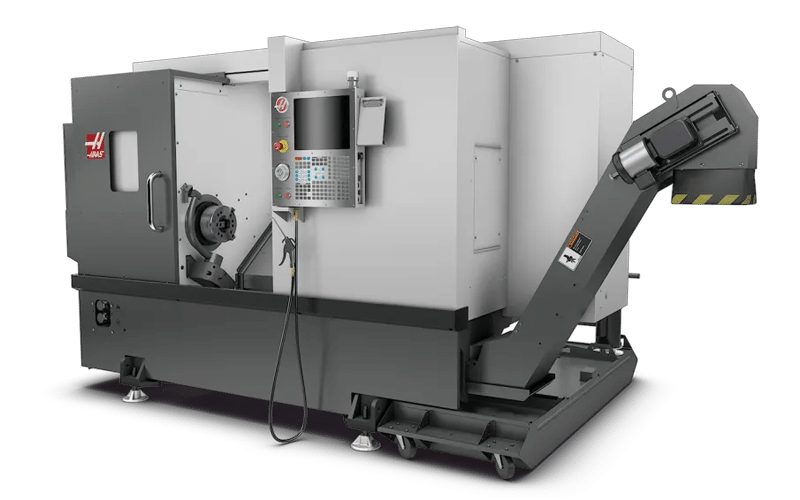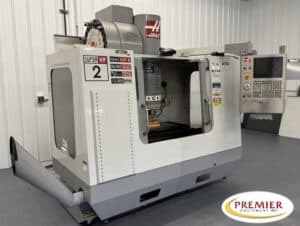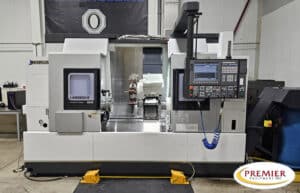The alphabet soup of model designations can be intimidating when you browse used CNC machine listings or walk into a Haas Factory Outlet. What do the letters and numbers VF-2SS, ST-30, DT-1, and EC-400 actually mean, and more significantly, which series best suits your manufacturing requirements?
Every Haas series reflects a unique engineering philosophy created for particular parts, production volumes, and applications. While picking the incorrect series can lead to inefficiencies, picking the correct one can increase output and profitability.
Having assisted manufacturers in making decisions about CNC equipment for 37 years, we have witnessed the significant impact that appropriate series selection has on shop performance. Every major Haas machine series is broken down in this in-depth guide, which also explains how to choose between similar models and what each one does best.
Knowing these series differences will help you save time, money, and frustration whether you’re expanding your fleet or purchasing your first Haas machine.
Understanding Haas’s Series Philosophy
It’s crucial to comprehend how Haas arranges their product lineup before delving into individual series. Haas uses a logical hierarchy, in contrast to some manufacturers who produce overlapping model ranges with ambiguous distinctions:
Entry-Level Capability: CNC machines made for new shops, educational institutions, or companies with simple machining requirements. These models uphold Haas quality standards while emphasizing affordability and usability.
Production Workhorses: The majority of American manufacturing is done by mid-range machines. These series provide the ideal balance of value, capability, and dependability that made Haas famous.
High-Performance Solutions: sophisticated CNC machines for demanding applications that call for increased speed, accuracy, or multi-axis capability. These offer specialized performance at premium prices.
Specialized Applications: equipment designed specifically for a particular manufacturing niche, such as complex 5-axis work, high-speed drilling, or large-format routing.
You can precisely match equipment to your needs with this tiered approach without having to pay for extra capability or accept subpar performance.
Haas VF Series
Vertical Machining Centers (The Industry Standard)
The VF (Vertical Format) series represents Haas’s core vertical machining center lineup and remains the most popular CNC mill series in North America. These machines handle general-purpose milling, drilling, and tapping operations on parts where the spindle approaches from above.
Model Range and Sizing
The VF series spans from compact to large-capacity machines:
| Model | Travel (X × Y × Z) | Description |
|---|---|---|
| VF-1 | 20″ × 16″ × 20″ | Ultra-compact for limited floor space |
| VF-2 | 30″ × 16″ × 20″ | America’s best-selling vertical mill |
| VF-3 | 40″ × 20″ × 25″ | Extended capacity for larger work |
| VF-4 | 50″ × 20″ × 25″ | Large part capability |
| VF-5 | 60″ × 26″ × 26″ | Production-scale capacity |
| VF-6 | 64″ × 28″ × 30″ | Heavy-duty large format |
| VF-8 | 64″ × 40″ × 30″ | Maximum Y-axis reach |
| VF-9 | 84″ × 40″ × 30″ | Longest X-axis in series |
With this progressive sizing, you can find the right size for your needs without having to buy too big of equipment when a smaller one will do.
Spindle Variations
Haas offers multiple spindle configurations within the VF series:
- Standard Spindle: 8,100-10,000 RPM with 30 HP – General-purpose workhorse for steel, aluminum, and most materials
- High-Speed Spindle (SS models): 12,000 RPM with 40 HP – Optimized for aluminum, composites, and non-ferrous materials requiring rapid metal removal
- High-Torque Spindle (TR models): Lower RPM with increased torque – Ideal for heavy steel cutting and hard materials
Because of this spindle variety, you can choose VF series machines that are optimized for your particular material mix without sacrificing performance.
Ideal Applications
The VF series excels at:
- General job shop machining across diverse materials
- Mold and die work requiring vertical spindle orientation
- Fixture and tooling fabrication
- Aerospace component machining
- Medical device manufacturing
- Automotive prototype and production
When to Choose VF Series: If your work primarily involves parts that fit on a machine table with vertical spindle access, VF machines offer unbeatable versatility and value. Browse our VF series inventory to find the right capacity for your shop.
Haas ST Series
Turning Centers (Lathe Solutions)
Cylindrical parts that need to be turned, faced, threaded, and bored are handled by the ST (Slant bed Turning Center) series. Precision, speed, and automation are added to traditional lathe work by these CNC lathes.
Model Range and Capacity
| Model | Chuck Size | Description |
|---|---|---|
| ST-10 | 10″ | Compact footprint – Entry-level turning |
| ST-15 | 12″ | Extended capacity – Small to medium parts |
| ST-20 | 12″ | 20.5″ between centers – Job shop standard |
| ST-25 | 15″ | Extended length – Larger diameter work |
| ST-30 | 15″ | Enhanced rigidity – Production turning |
| ST-35 | 18″ | Heavy-duty – Large part capability |
Growing part sizes are supported by the series progression, which keeps control systems and operational logic uniform across all models.
Key Turning Features
Live Tooling: The majority of ST series machines have live tooling capability, which enables powered tools to carry out tapping, drilling, and milling tasks while the machine is turning. Accuracy is increased and secondary operations are eliminated with this mill-turn capability.
C-Axis Functionality: For mill-turn operations, servo-driven spindle indexing allows for precise angular positioning, allowing for the creation of features like flats, keyways, and off-center holes without the need for part rehandling.
Dual Spindles: For full part processing in a single cycle, higher-end ST models come with optional sub-spindles. The sub-spindle receives the part and machines the other end, while the main spindle machines the other end.
Turret Configurations: While larger capacities and optional servo turrets accommodate complex tooling requirements, standard 12-position turrets handle the majority of applications.
Ideal Applications for ST Series
ST series machines excel at:
- Shaft and spindle manufacturing
- Hydraulic and pneumatic components
- Valve bodies and fittings
- Automotive components
- Medical implant production
- Any cylindrical parts requiring precision turning
When to Choose ST Series: If you have to remove material from rotating parts around a central axis, the ST series lathes are the best option.
Haas DT Series
Drill/Tap Centers (High-Speed Production)
Haas’s specialized high-speed machining centers for quick drilling, tapping, and light milling operations on smaller parts are represented by the DT (Drill/Tap) series. These devices drastically boost speed and productivity at the expense of work envelope.
Model Specifications
| Model | Travel (X × Y × Z) | Spindle Speed |
|---|---|---|
| DT-1 | 20″ × 16″ × 16″ | 10,000 RPM |
| DT-2 | 29″ × 16″ × 16″ | 10,000 RPM |
Both models feature:
- Rapid traverse rates up to 1,400 IPM
- High-speed automatic tool changers (2.8 second chip-to-chip)
- Compact footprint for efficient floor space utilization
- 24-position tool capacity standard
Performance Advantages
When machining specific work, DT series machines achieve cycle times 30–50% faster than similar VF models. Because of the lighter machine structure made possible by the smaller work envelope, aggressive acceleration and deceleration are possible without compromising accuracy.
The high-speed tool changer is especially useful for parts that need frequent tool changes, such as light chamfering cycles, tapping different threads, and drilling holes of different sizes.
Ideal Applications
DT series machines excel at:
- Electronic enclosure manufacturing
- Small bracket and mounting plate production
- High-volume drilling and tapping operations
- Light aluminum part manufacturing
- Medical device component production
When to Choose DT Series: DT machines are more productive than standard vertical mills if your typical parts fit within the reduced work envelope and require mainly drilling, tapping, and light milling. However, accurately determine your actual part size requirements rather than sacrificing the necessary work envelope for speed.
Haas EC Series
Horizontal Machining Centers (Production Power)
Haas’s horizontal machining center lineup is represented by the EC (Enclosed Column) series, in which the spindle approaches parts from the side rather than above. For certain production scenarios, this orientation offers clear benefits.
Model Range and Features
| Model | Pallet Size (X × Y × Z) | Spindle Speed |
|---|---|---|
| EC-400 | 20″ × 20″ × 20″ | 12,000 RPM |
| EC-500 | 21.26″ × 21.26″ × 24.8″ | 12,000 RPM |
| EC-630 | 24.8″ × 24.8″ × 24.8″ | 12,000 RPM |
| EC-1600 | 63″ × 50″ × 50″ | High-power spindle |
All EC models include:
- Automatic pallet changers for continuous operation
- Four-axis rotary table capability
- High-torque spindles for aggressive cutting
- Enclosed work zones for chip and coolant containment
Horizontal Machining Advantages
Chip Evacuation: During horizontal operations, chips are naturally removed from the work area by gravity, preventing chip recutting and tool damage.
Tool Life: Especially for ferrous materials that need heavy cutting, improved coolant access and chip clearing greatly increase tool life.
Automation Ready: Pallet changers allow for true lights-out manufacturing, which allows for continuous production by loading parts onto one pallet while the machine operates on the other.
Fourth-Axis Access: By eliminating the need for manual part repositioning, the rotary table offers effective four-sided machining, increasing accuracy and cutting down on cycle time.
Ideal Applications
EC series machines excel at:
- Automotive component production runs
- Complex engine block and transmission case machining
- Aerospace structural components
- Mold and die production
- Any production scenario benefiting from automated pallet changing
When to Choose EC Series: Horizontal machining centers provide productivity gains that justify their higher cost if you need lights-out capability or run production quantities (50+ parts) that require four-sided machining. However, versatile vertical mills usually provide better value for job shops that handle a variety of one-off work.
Haas UMC Series
Universal Machining Centers (5-Axis Capability)
The Haas lineup offers 5-axis simultaneous machining capability thanks to the UMC (Universal Machining Center) series, which allows for intricate contour cutting and access to part features from almost any angle.
Model Specifications
| Model | Travel (X × Y × Z) | Table Type |
|---|---|---|
| UMC-500 | 20″ × 16″ × 20″ | Trunnion-style table |
| UMC-750 | 30″ × 20″ × 24″ | Trunnion-style table |
| UMC-1000 | 40″ × 26″ × 25″ | Trunnion-style table |
All UMC models feature:
- Full 5-axis simultaneous contouring
- ±110° tilting trunnion table
- High-speed spindles (12,000-15,000 RPM)
- Advanced Haas control with 5-axis programming support
5-Axis Applications
True 5-axis machining provides several critical advantages:
Complex Geometry: 3-axis equipment cannot create machine-sculpted surfaces, impellers, turbine blades, or organic shapes.
Single-Setup Accuracy: By removing setup errors, this feature allows you to access multiple part faces without having to reorient the workpiece and maintain tight tolerances.
Tool Life Extension: For optimal cutting conditions, continuously adjust the cutting tool angle so that the tools are perpendicular to the work surface.
Undercut Capability: Machine characteristics that call for specialized fixtures or EDM operations on three-axis equipment are known as undercut capabilities.
Ideal Applications
UMC series machines excel at:
- Aerospace component manufacturing
- Medical implant production (complex anatomical shapes)
- Die and mold making (complex cores and cavities)
- Automotive prototype parts
- Energy sector components (impellers, turbine blades)
When to Choose UMC Series: 5-axis capability makes the investment worthwhile if your work frequently involves intricately contoured surfaces, demands single-setup accuracy across multiple faces, or involves specialized aerospace or medical applications. But make sure you know how to program—5-axis CAM software and skilled programmers are necessary to fully utilize these machines.
Haas GR Series
Gantry Routers (Large-Format Machining)
Larger parts that are larger than what can be handled by a traditional machining center are handled by the GR (Gantry Router) series, especially non-metallic materials like composites, polymers, and wood products.
Model Range
| Model | Travel (X × Y × Z) |
|---|---|
| GR-510 | 51″ × 102″ × 12″ |
| GR-712 | 72″ × 144″ × 12″ |
These machines feature:
- Moving gantry design for large work envelope
- High-speed spindles optimized for non-ferrous materials
- Vacuum table workholding for flexible material clamping
- Dust collection systems for clean operation
Specialized Applications
GR series machines excel at:
- Composite aerospace panel machining
- Large plastic part manufacturing
- Sign and display production
- Architectural component fabrication
- Pattern and template making
When to Choose GR Series: Haas Gantry routers offer much more effective solutions than trying to process large-format non-metallic materials or composite structures on conventional machining centers.
Comparison Chart: Choosing Between Series
| Series | Best For | Typical Parts | Production Volume | Investment Level |
|---|---|---|---|---|
| VF | General milling | Job shop diversity | 1-500+ pieces | Moderate |
| ST | Turning operations | Cylindrical parts | 1-1000+ pieces | Moderate |
| DT | High-speed drilling | Small parts | 100-10,000+ pieces | Moderate |
| EC | Production milling | Complex 4-sided | 50-5,000+ pieces | High |
| UMC | 5-axis complexity | Sculptured surfaces | 1-100 pieces | High |
| GR | Large composites | Oversized panels | 1-50 pieces | Moderate-High |
Making Your Series Selection Decision
Follow this decision framework when choosing Haas series:
Step 1: Define Your Part Characteristics
- Typical size range (smallest to largest)
- Material types (aluminum, steel, plastics, composites)
- Geometric complexity (simple 3-axis vs complex contours)
- Orientation requirements (vertical spindle vs horizontal)
Step 2: Assess Production Volumes
- Typical lot sizes per job
- Annual part variety (50 different parts vs 5 production runners)
- Automation requirements (attended vs lights-out)
Step 3: Evaluate Shop Constraints
- Available floor space and ceiling height
- Power availability (standard 230V vs 460V)
- Operator skill levels
- Budget parameters
Step 4: Match Series to Requirements
- Job shops with diverse work → VF + ST series combination
- Production shops with repeating parts → EC series consideration
- Complex aerospace/medical work → UMC series evaluation
- Large non-metallic work → GR series assessment
Understanding Model Numbers Within Series
Haas uses logical numbering within each series:
Higher Numbers = Larger Capacity: VF-2 < VF-3 < VF-4 indicates progressive work envelope expansion
Letter Suffixes Indicate Variants:
- SS = Super Speed (high RPM spindle)
- TR = High Torque (low RPM, high power)
- YT = Extended Y-axis travel
- XT = Extended travels (multiple axes)
Understanding these conventions helps decode model listings and identify ideal configurations for specific applications.
Buying Used: Series Considerations
The choice of series becomes even more crucial when purchasing used Haas equipment:
VF and ST Series: It’s simpler to locate particular configurations due to their widespread availability. These series provide simple serviceability and hold their value well.
DT Series: Because of its specialized nature, the DT Series is less common in used markets. Before making a commitment, make sure the machine meets your actual production needs.
EC Series: Pay close attention to pallet changer mechanisms; these frequently used parts need to be maintained. Check that every safety interlock is operating as intended.
UMC Series: Examine the accuracy and calibration of the 5-axis in the UMC Series. Set aside money for possible rotary axis rebuilds on machines with more hours. Make sure you have access to trained repair technicians.
When assessing used equipment, make sure to check the spindle condition, machine hours, and overall maintenance history regardless of the series.
Conclusion
Series Selection Drives Success
Knowing how Haas organizes its machine series has a direct impact on your competitive positioning, profitability, and manufacturing efficiency; it is not merely academic knowledge. Specialized series like DT, EC, UMC, and GR handle particular production scenarios, the ST series offers complete turning solutions, and the VF series offers unparalleled versatility for general milling.
The secret is to honestly evaluate your current needs in comparison to your desired capabilities. An underutilized UMC-750, which appeared impressive at the time of purchase, is significantly outperformed by a well-chosen VF-2 operating at 80% utilization.
Start with flexible workhorse series like VF and ST, and as your company exhibits particular needs through real-world work patterns, add specialized capability. This methodical approach preserves operational flexibility while optimizing equipment return on investment.



